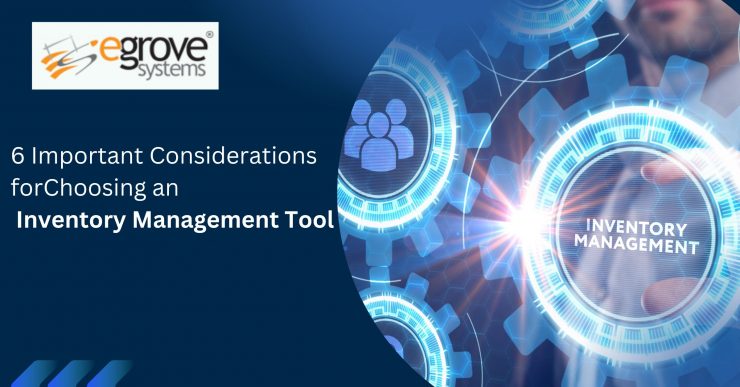Inventory management is the process of managing the inventory of goods and materials needed to run your business. Inventory management in eCommerce involves tracking and managing the stock of products sold online, including adding new products, updating availability, and tracking orders and shipments. It helps businesses meet customer demand, avoid running out of stock, and save time and money by avoiding overstocking and spoilage. Key considerations include forecasting demand, setting reorder points, and tracking and monitoring inventory.
As a business owner or manager, choosing the right inventory management tool is crucial for the success of your company. There are many options on the market, so it can be overwhelming to determine which one is the best fit for your business.
Here are six important considerations to keep in mind when selecting an inventory management tool:
- Cost
Tools should meet your budget and be fairly priced. Compare the prices of several solutions and throw in other expenses like training and maintenance fees.
When selecting an inventory management platform for your company, price is a key factor to take into account. The market offers a broad variety of products at various price points. It’s crucial to pick a tool that matches your budget while still having the features and capabilities you want.
Before making a choice, compare the prices of various inventory management software and take into account additional charges like training and maintenance fees. Some products cost a one-time charge to acquire, while others require a monthly or yearly membership.
It’s crucial to take the tool’s overall cost into account. Cheaper choices could first look alluring, but they might lack capabilities that enable business development or necessitate further expenditures. Although it might be costly, cutting-edge features and effective inventory management can ultimately cost you less.
The ideal inventory management solution for your company is one that provides the capabilities you want at a cost that is affordable. You may make decisions that are well-informed and ultimately beneficial to your organization by carefully comparing the expenses of various solutions.
2. Ease of use
The tool should be simple to use and navigate. Additionally, it must be simple to use so that groups can quickly adapt.
When selecting an inventory management platform for your organization, usability is a key factor to take into account. Tools that are challenging to use and operate can waste time and reduce the effectiveness of your team.
Look for straightforward and user-friendly inventory management software. You need a user interface that is clear and simple to comprehend. Think about the learning curve of your staff. Will the team be able to rapidly become used to using the technology, or will substantial training be necessary?
The tool’s interoperability with the existing workflows and procedures used by your team should also be taken into account.
Tools that smoothly integrate into your current system are simple to use and increase productivity.
3. Including additional systems in the process
If you already use another piece of software for your company, choosing an inventory management technology that interfaces well with a POS system or accounting system, for instance, is crucial.
When selecting an inventory management platform for your business, integration with other systems is a crucial factor to take into account. If your business already employs another piece of software for instance, it’s crucial to pick an inventory management platform that connects well with accounting and point-of-sale systems.
Workflows are streamlined and productivity is increased by using inventory management technologies that effortlessly integrate with your current systems. You can save time and lower the chance of error, for instance, if your inventory management solution can automatically update your accounting software with inventory data.
On the other hand, manually entering data is time-consuming and prone to mistakes using tools that are not integrated with current systems. Managing system interconnections may also need additional resources.
Overall, selecting an inventory management solution that is simple to combine with other systems can increase the precision and efficiency of your workflow, boosting the productivity and profitability of your company.
Read also:- Best Practices for Ensuring the Document Management Security
4. Analysis and reporting
Analytics and reporting are crucial components of inventory management because they give businesses significant new information about their inventory data. Organizations may decide how to run their operations with the help of accurate reporting and analysis, what’s in stock, how much ordering is required, and when you plan to place another order.
Following are some examples of how analytics and reporting may help with inventory management:
Recognize patterns: By examining data on sales, inventory levels, and other elements, organizations may recognize trends in inventory data, which they can then use to forecast future demand and improve inventory decisions.
Improve your inventory management: By examining sales and inventory data, companies may identify the ideal inventory levels to keep in place in order to satisfy demand without running out of stock.
Reduce waste: Businesses may find product and process problems that lead to waste and take action to fix them by reviewing returns and credit data.
Enhanced effectiveness: Companies might find chances to simplify inventory management procedures and cut expenses by looking at purchase orders and other aspects.
5. Scalability
As your company expands, you need inventory management technology that can scale. Look for tools that won’t make you slower as your inventory and sales grow.
Scalability is vital in a number of crucial areas of inventory management, they are:
Growth management: The demand for your inventory may rise as your company expands. Businesses may scale up to handle this growing demand without having to dramatically alter their inventory management procedures or spend money on new technologies.
Adapting to changing demand: Some businesses face shifting demand for their goods and services. These swings may be managed using a scalable commodities management system without affecting business operations as a whole.
Avoid bottlenecks: If your inventory management system is not scalable, it may get overwhelmed as demand rises or a high volume of transactions is processed at once. Order processing delays and bottlenecks might result from this, which would be annoying for customers and expensive for your businesses.
6. Customer Support
Pick a tool with dependable customer service so you can obtain assistance immediately away if you have any problems.
Customer service may be crucial to inventory control since it makes sure that customers’ demands and complaints are attended to in a prompt and satisfactory way. Providing excellent customer service encourages client loyalty, which promotes repeat business and good word of mouth.
Customer support representatives handle inquiries and complaints from customers, processing returns and credits, and providing product information. They help resolve issues with orders, handle returns and exchanges for defective or problematic products, and provide information to help customers make informed purchasing decisions.
Conclusion
Choosing the right inventory management tool is essential for the success of any business. There are several important considerations to keep in mind when making this decision, including the size and needs of your business, the features and capabilities of the tool, and the cost and implementation process.
By carefully evaluating your options and considering the specific needs of your businesses, you can select an inventory management tool that will help streamline your operations and improve efficiency.
















Add comment